Michelle Kaffenberger
Blavatnik School of Government, University of Oxford
Blog
On Thursday the World Bank launched its new Learning Poverty measure, to serve as a rallying cry for improved learning. It is intended to be the learning equivalent of the $1/day poverty line, measuring the percent of children below a low learning threshold—those who cannot read a simple passage by age 10. Shockingly, it finds that in low-income countries, 89 percent of children do not meet this threshold. As a means to an end, the end being high-quality education for all, such a measure will draw needed attention to the exceedingly low levels of learning in many low- and middle-income countries. Acquiring universal, early, conceptual and procedural mastery of basic skills should be a priority for all education systems. As with the poverty line, though, the aims of education obviously do not stop with getting children across this low threshold. The goal of eliminating learning poverty should be to put more children on a learning trajectory that will enable them to achieve many years of meaningful education.
Learning profiles reveal just how low learning of even basic skills in the early years is, on average, in many low- and middle-income countries. Nationally representative surveys with a simple literacy test show that often half or more of young adults who have completed primary school and no further lack even basic functional literacy (Figure 1). Similar analysis of Demographic and Health Surveys show that across 51 countries, only half of young women with six years of schooling (and no higher) can read a simple sentence. This is a lower bar than the Learning Poverty measure of reading and understanding a simple passage, indicating these countries will perform even worse on the new learning poverty measure.
Further, recent work on Indonesia shows that the learning profile for basic math skills flattens in the later years. Figure 2 shows (using IRT scores) that the ability to answer a simple math question correctly stops increasing after grade 6. If children haven’t gained the skill by that point, they don’t gain it later on, regardless of how many additional years they spend in school. This makes ensuring mastery of basics in the early years all the more important.
Figure 1. On average, half of young adults who completed primary school (and no higher) lack basic functional literacy
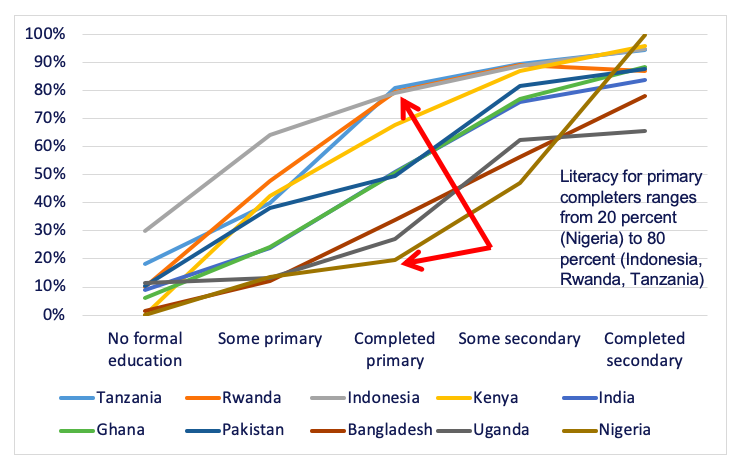
Figure 2. In Indonesia, the overall IRT (Item Response Theory) aggregated arithmetic score shows no improvement after grade 6
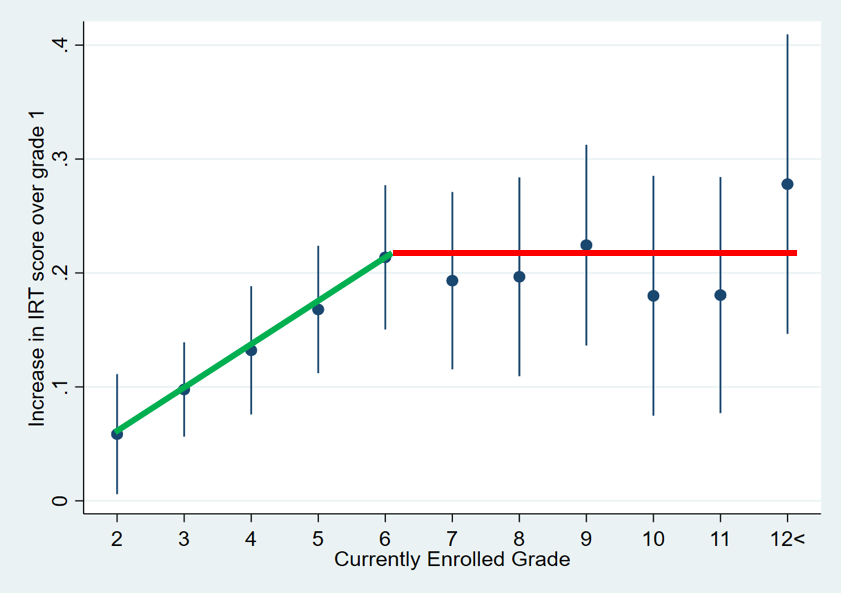
Evidence also shows that differences in learning emerge early, both between countries and within countries, so ensuring education systems get all children past a basic learning threshold is an important aim. The learning profiles in Figure 1 show that by primary completion, literacy varies across the ten countries from as low as 20 percent, to as high as 80 percent. Within countries, ASER and Uwezo surveys show that in Kenya and India, by age eight, children in the poorest two quintiles by wealth are more than 20 percentage points less likely to have achieved basic local-language literacy as those in the top quintile, and the differences continue to grow. By age ten (the focus of the Learning Poverty measure), the gap has grown to about 30 percentage points in both countries.
Figure 3. Learning differences emerge early in many countries
| Kenya | India |
|---|---|
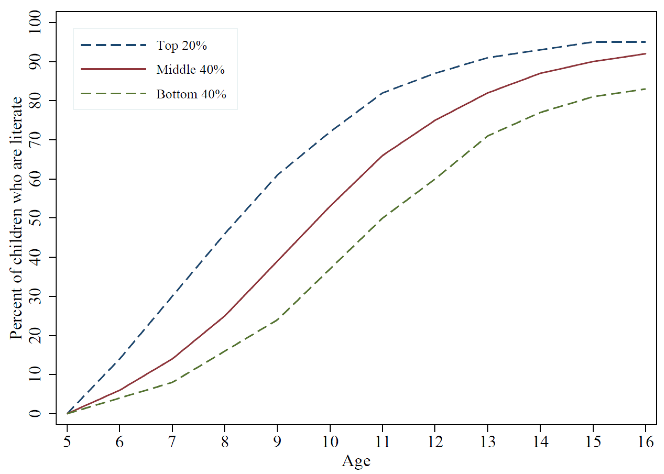
|
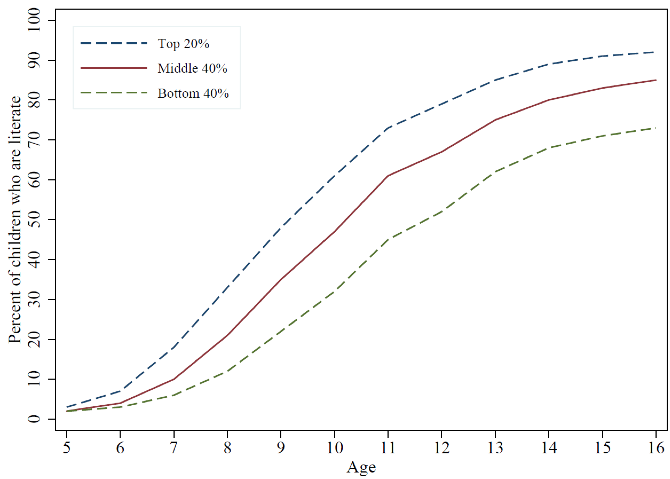
|
| Source: Akmal & Pritchett |
So, as a means for drawing attention to such low mastery of foundational skills, and spurring progress towards eliminating such deprivation, the Learning Poverty measure is welcome. However, achieving a basic skill by age 10 is also not the end goal of an education system—education systems also aim to impart much higher capabilities and skills that will enable children to fully participate as productive members of their society. On that note, a word of caution.
Just like the goal of eliminating poverty was never to just get people over a threshold to making $1.01/day, but rather to put them on a trajectory to higher incomes and living standards, so eliminating “learning poverty” would be a first step towards putting children on a trajectory to achieve higher quality education for many additional years. A steeper, early learning profile is actually a strategy for getting children more schooling and higher-order skills because it puts them on the right trajectory.
Take the illustrated learning profiles in Figure 4. Getting children to stay in school for more years on a flat learning profile, as illustrated with the pink line, won’t reach basic threshold goals, like the learning poverty line, or aspirational goals, like a full set of skills and capabilities for adult life, because children learn too little per year. Steepening the learning profile to reach threshold goals early on (like the yellow line) is an improvement, but education doesn’t stop there. It’s a necessary but not sufficient condition for achieving aspirational goals for all.
Figure 4. Aiming for the aspirational goals requires achieving the threshold goals on the way
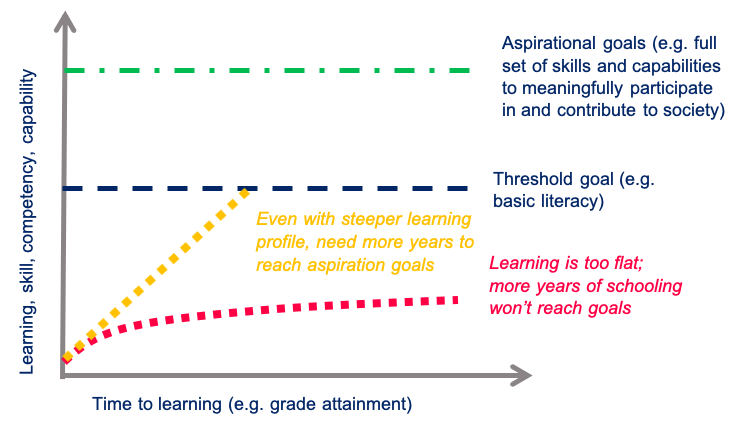
Reducing “learning poverty” will also help achieve aspirational goals by enticing children to stay in school longer—extending the yellow learning profile in Figure 4. Evidence suggests that many children who drop out of school do so because learning is so low. In Kenya for example, a study found that low learning was underlying many proximate determinants of dropout. And a study in Mexico found that a secondary school scholarship program had no impact in part because eligible students had such low learning levels they knew they couldn’t fully participate in secondary school and chose not to make use of the scholarship. This means steepening the learning profile in the early years can be a win-win, both getting children the basic skills they should achieve during those years plus getting them to stay in school longer, helping achieve both schooling and learning goals.
If a high-quality education is like a marathon, the learning poverty measure is like mile marker 2. You have to pass it to reach the finish line, but passing it doesn’t mean you’ve finished. It means you’re moving in the right direction. Mile markers are good. They keep you motivated and allow you to measure progress. To the extent that the learning poverty measure serves as a motivator and a measure of progress on early basic skills, it should serve as a useful measure to countries to gauge where they are. But to achieve learning for all, they’ll need to continue running the race once they pass that marker.
RISE blog posts and podcasts reflect the views of the authors and do not necessarily represent the views of the organisation or our funders.